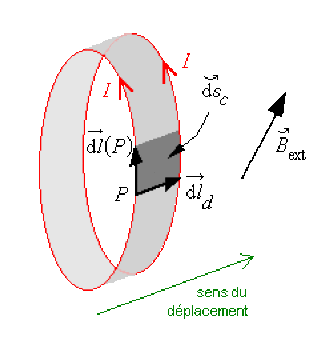Travail des forces magnétiques dans le cas d'un déplacement élémentaire
Considérons un circuit filiforme \(\mathfrak{D}\) rigide, parcouru par un courant d'intensité \(\mathsf{I}\) et placé dans un champ magnétique \(\stackrel{\hookrightarrow}{B_{\mathrm{ext}}}\). Il est donc soumis à la force de Laplace qui peut provoquer son déplacement et il s'agit de calculer le travail de cette force si un déplacement élémentaire \(\overrightarrow{\mathrm{d} l}_d\) de \(\mathfrak{D}\) se produit.
L'élément de courant \(I \overrightarrow{\mathrm{d} l}(P)\) est soumis à la force :
\(\overrightarrow{\mathrm{d}F}_m(P) = I\overrightarrow{\mathrm{d}l}(P) \wedge \stackrel{\hookrightarrow}{B_{\mathrm{ext}}}(P)\)
Le travail \(\delta w\) de \(\overrightarrow{\mathrm{d}F}_m\) au cours du déplacement \(\overrightarrow{\mathrm{d}l}_d\) a pour expression :
\(\delta w = \overrightarrow{\mathrm{d}F}_m(P) . \overrightarrow{\mathrm{d}l}_d = [I \overrightarrow{\mathrm{d}l}(P) \wedge \stackrel{\hookrightarrow}{B_{\mathrm{ext}}}(P)] . \overrightarrow{\mathrm{d}l}_d\)
Le produit mixte[1] peut s'écrire d'une autre manière, ce qui donne :
\(\delta w = I[\overrightarrow{\mathrm{d}l}_d \wedge \overrightarrow{\mathrm{d}l}(P)] . \stackrel{\hookrightarrow}{B_{\mathrm{ext}}}(P)\)

En posant \(\stackrel{\hookrightarrow}{\mathrm{d}s}_c = \overrightarrow{\mathrm{d}l}_d \wedge \overrightarrow{\mathrm{d}l} (P)\) on peut écrire :
\(\delta w = I \stackrel{\hookrightarrow}{\mathrm{d}s}_c . \stackrel{\hookrightarrow}{B_{\mathrm{ext}}}(P)\)
\(\mathrm{d}s_c\) est l'aire de la surface balayée ou "coupée" par \(\overrightarrow{\mathrm{d}l}(P)\) au cours du déplacement \(\overrightarrow{\mathrm{d}l}_d\) ; son orientation est déterminée par le produit vectoriel[2] : \([\overrightarrow{\mathrm{d}l}_d \wedge \overrightarrow{\mathrm{d}l}(P)]\)
En appelant \(\delta\phi_c\) le flux coupé par \(\overrightarrow{\mathrm{d}l}(P)\), on a : \(\delta w = I \delta\phi_c\)
Le travail effectué au cours du déplacement \(\overrightarrow{\mathrm{d}l}_d\) par l'ensemble de toutes les forces de Laplace agissant sur tous les éléments du circuit est : \(\delta W = I \delta\Phi_c\)
Ce résultat est vrai même en régime variable car il découle directement de la relation de Lorentz.